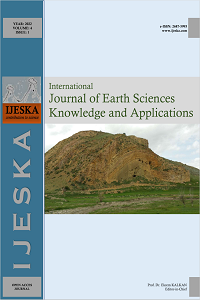Alkali Silica Reactivity Potential of Laki Limestone as Coarse Aggregate by Using Petrographic Examination
Abstract
Present study is aimed at assessment of Alkali Silica Reactivity potential of Laki limestone as coarse aggregate from Nooriabad area, district Jamshoro, Pakistan. Eleven coarse aggregate samples were collected for petrographic examination using optical microscope. It is observed that the aggregate comprises of hard, compact, massive, crystalline and fossiliferous limestone. As per Dunham classification of limestone, Laki limestone can be classified in decreasing order as Mudstone>Pack stone>Wackestone. Microfractures are obvious in some of the collected samples indicating the imprint of compressional tectonic forces. Large number of samples showing Mudstone suggest calm quite environment of deposition where clastic influx is less likely to be deposited. Hence, limestone is devoid of any reactive silica and free from chert, chalcedony and other harmful constituents like clays or organic matter. It is concluded that Laki limestone is suitable for use as road aggregate and concrete mix design.
References
- ASTM C295/C295M-19, 2019. Standard Guide for Petrographic Examination of Aggregates for Concrete. ASTM International, West Conshohocken, PA. Available at: www.astm.org.
- Chaudhry, M.N., Zaka, K.J., 1998. Petrographic Evaluation of Alkali Aggregate Reaction in Concrete Structures of Warsak Dam, N.W.F.P. Pakistan - A Case Study. 8th International Congress, Association of Engineering Geology and Environment 2841-2846.
- Cody, R. D., Spry, P. G., Cody, A. M., Gan, G., 1994. The Role of Magnesium in Concrete Deterioration. Iowa DOT HR-335. Final Report.
- Diamond, S., 1989. ASR- Another look at mechanisms. Proceedings of the 8th International Conference on Alkali-Aggregate Reaction, (Ed. K.Okada, S. Nishibayashi, and M. Kawamura), Kyoto, Japan, pp. 83-94.
- Dunham, R.J., 1962. Classification of carbonate rocks according to depositional texture. In W.E. Ham (ed.), Classification of carbonate rocks. Memoir - American Association of Petroleum Geologists, 1. American Association of Petroleum Geologists, Tulsa, 108-121.
- Farny, J.A., Kosmatka, S.H., 1997. Diagnosis and Control of Alkali-Aggregate Reactions in Concrete. Portland Cement Association, No. 2071, pp 1-24.
- Gillot, J.E., Swenson, E.G., 1969. Mechanism of Alkali-Carbonate Rock Reaction. Quarterly Journal of Engineering Geology 2, 7-23.
- Gondal, M.M.I., Ahsan, N., Javid, A.Z., 2008. Evaluation of ShakiSarwar and RajanPur aggregates for construction in southern Punjab province, Pakistan. Geological Bulletin of the Punjab University 43, 101-107.
- Gress, D., 1997. Early Distress in Concrete Pavements. FHWA-SA-97-045, Federal Highway Administration, Washington DC, 53 pp.
- Hobbs., D.W., 1978. Expansion of concrete due to the alkali-silica reaction: an explanation. Magazine of Concrete Research 30, 215-220.
- Hobbs, D.W., 1988. Alkali-silica reaction in concrete. Thomas Telford Ltd., London, UK.
- Jamkar, S.S., Rao, C.B.K., 2004. Index of Aggregate Particle Shape and Texture of coarse aggregate as a parameter for concrete mix proportioning. Cement and Concrete Research 34 (11), 2021-2027.
- Kazmi, A.H., Jan, M.Q., 1997. Geology and tectonics of Pakistan. Graphic Publishers, Karachi, Pakistan.
- Kosmatka, S., Kerkhoff, B., Panarese, W., 2003. Aggregates for Concrete, Design and Control of Concrete Mixtures. 14th Ed. Portland Cement Association, USA.
- Kurugöl, S., Güleç, A., 2012. Physico-chemical, petrographic and mechanical characteristics of lime mortars in historic Yoros Castle (Turkey). International Journal of Architectural Heritage 6 (3), 322-341.
- Lopez-Buendia, A.M., Climent, V., Verdu, P., 2006. Lithological Influence of Aggregate in the Alkali- Carbonate Reactio. Cement and Concrete Research 36 (8), 1490-1500.
- Mindess, S., Young, J.F., 1981. Concrete. Prentice-Hall, Inc., Englewood Cliffs, NJ. 671 pp.
- Nixon, P.J., Sims, I., 2006. Alkali–reactivity and Prevention – Assessment, Specification, and Diagnosis of Alkali– reactivity, International Union of Laboratories and Experts in Construction Materials, Systems and Structures (RILEM), International Specification to Minimise Damage from Alkali Reactions in Concrete: Part 1 Alkali–Silica Reaction, RILEM TC 191–ARP AAR–7.1.
- Nuttall, W.L.F., 1925. The stratigraphy of the Laki Series (Lower Eocene) of parts of Sind and Baluchistan (India); with a description of the larger foraminifera contained in those beds. Quarterly Journal of the Geological Society 81 (1-4), 417-453.
- Smith, M R., Collis, L., 2001. Aggregates–Sand, Gravel and Crushed Rock Aggregates for Construction Purposes (3rd Edition). The Geological Society London. 339 p.
- Stanton, T.E., 1942. Expansion of concrete through reaction between cement and aggregate. Transactions of the American Society of Civil Engineers 107 (1), 54-84.
- Swamy, R.N., 1992. The Alkali-Silica Reaction in Concrete, Blackie, London.
- Tremblay, C., Berube, M., A., Fournier, B., Thomas, M.D.A., Folliard, K.J., 2008. Use of the Accelerated Mortar Test to Evaluate the Effectiveness of LiNO3 Against Alkali Silica Reaction Part 2: Comparison with Results from the Concrete Prism Test. Accepted for publication, Cement and Concrete Research, March 2008.
- Walcott, C.D., 1905. The Cambrian fauna of India. In Proceedings of the Washington Academy of Sciences 7, 251-256.
- Watters, W.A., 1969. Petrological examination of concrete aggregates. Proceedings of the National Conference on Concrete Aggregates, Hamilton, June 1969. N.Z. Portland Cement Association, Wellington, pp 49-54.
- Wenk, H.R., 1998. Deformation of Mylonites in Palm Canyon, California, Based on Xenolith Geometry. Journal of Structural Geology 20 (5), 559-571.
- West, G., 1996. Alkali-Aggregate Reaction in Concrete Roads and Bridges, Thomas Telford, London.
- Yu, Y., Zhang, C., Gu, X., Cui, Y., 2019. Expansion prediction of alkali aggregate reactivity-affected concrete structures using a hybrid soft computing method. Neural Computing and Applications 31 (12), 8641-8660.
Details
| Primary Language | English |
|---|---|
| Subjects | Geological Sciences and Engineering (Other) |
| Journal Section | Research Article |
| Authors | |
| Publication Date | November 1, 2021 |
| Published in Issue | Year 2022 Volume: 4 Issue: 1 |

